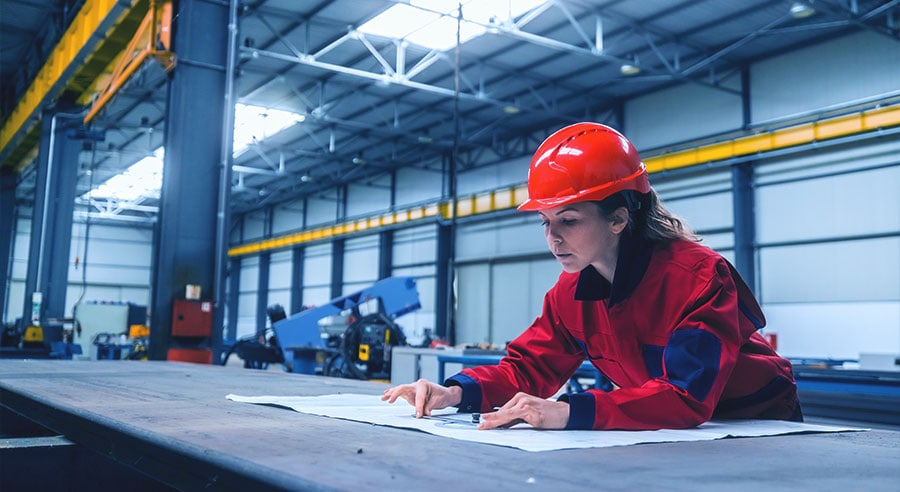Buy dark radiators: Convincing technologies at a glance
Save energy costs and protect the environment: Dark radiators are among the most efficient heating systems for halls that you can buy. But which infrared system is right for you? We give you an overview.
Dark radiators, also called infrared radiators, offer you more flexibility than classic heating systems. Why? Because the systems don't heat the air per se - a heating method that is comparatively inefficient. Instead, dark radiators transmit energy in the form of electromagnetic waves. When these waves hit a solid, the energy is converted into heat. This makes it possible to heat with the usage profile of a hall and to exclude layers of air above the usage area.
Another advantage: Since the heat does not take a detour via the air, the systems can be switched on and off as quickly as light. With this responsiveness, the heaters adapt perfectly to the dynamics of everyday life, such as when doors open. They only heat where heat is needed, thus saving energy. Up to 70 percent of energy costs can be saved compared to conventional heating systems. Employees also find the heat particularly pleasant because it resembles the natural heating principle of the sun. They can work correspondingly productively. So much for the advantages. But what technology should you know if you want to buy a dark radiator?
PRIMA entry-level line convinces with 60 % radiation efficiency
Do you have to do without infrared technology on a tight budget? Not at all, proves PRIMA. Even on a small budget, you can buy a dark radiator and benefit from its numerous advantages. The entry-level line from KÜBLER is inexpensive and yet powerful. It uses the best burner technology that we originally developed for the high-end MAXIMA series. The result is remarkable for a standard class heater. PRIMA brings a radiation efficiency of around 60 percent into the hall in the form of directly usable infrared heat.
This pays off directly for users of the technology. They save around ten percent on heating costs compared with conventional standard infrared units. The entry-level line is equally suitable for new halls and renovation projects. The only important factor is the ceiling height. It should be at least four meters.
OPTIMA high-performance infrared heating series: 72 % radiation efficiency
OPTIMA plus goes one step further. Since its introduction, this infrared heating series has been one of the most efficient and powerful dark radiators you can buy. KÜBLER has developed a burner technology especially for this series that ensures a homogeneous distribution of the gas-air mixture. It produces a long flame and scores with an excellent energy transfer from flame to radiant tube. As a result, the infrared heat is transferred evenly to the room environment - regardless of whether the hall height is four or 35 meters.
The outer shell of the high-end heater is also closed and fully insulated. The burner and radiation tube are geometrically optimized so that as little heat as possible escapes upwards. The bottom line is that OPTIMA plus achieves a radiation efficiency of 72 percent. Depending on the hall project, operators can save up to 30 percent energy compared to conventional infrared technologies. The investment in OPTIMA plus therefore pays for itself in two to five years.
MAXIMA: How to buy a dark radiator that reaches 80% radiation efficiency
The MAXIMA series is KÜBLER's high-efficiency line. In six years of development, the engineers have succeeded in setting benchmarks in the world of dark radiators with new technologies. For example, they have developed a new burner technology - including a system that preheats the combustion air. It achieves an enormously high radiation efficiency of 80 percent (measured according to DIN EN 416-2) with minimized convection losses. As a result, users save up to 45 percent in energy costs compared to standard infrared heaters. They also protect the environment thanks to low consumption values and the hearing of their employees. Because no infrared heating system is quieter. Last but not least, the MAXIMA series impresses with its design. This is confirmed not only by numerous customers across countries, but also by the international design competition "Design Plus powered at ISH". It has awarded MAXIMA with a seal of quality.
In addition to the MAXIMA, OPTIMA plus and PRIMA series of dark radiators, KÜBLER also offers other infrared systems that can be individually adapted to hall geometries: For example, the NRV multiburner system. These are multi-torches connected in series - with a continuous radiation tube. They are ideal for large areas and low ceiling heights.
Buy intelligent control systems for more efficiency to complement the dark radiator
In order to buy a dark radiator that can unleash its full energy-saving potential, you need another key component in addition to the devices: intelligent control systems. KÜBLER specializes in their development. To optimize the control of hall heating systems, we have developed a modular control system called CELESTRA. This is a highly functional, intuitive control cockpit that allows users to adapt system operation to changing requirements and run at optimum efficiency levels. Up to 20% additional savings can be generated in this way - even more depending on the project.
One of the most important modules: E.M.M.A. (Energy Monitoring & Management Application). With this intelligent software tool, users analyze, archive, compare and document temperature curves, heating outputs and consumption data. In this way, you gain important information for the continuous optimization of the heating process and create the basis for certifications or audits, for example, according to DIN EN ISO 50001.
Saving even more energy: H.Y.B.R.I.D. overall system recovers heat from waste gas from hall heating systems and production processes
KÜBLER offers much more than just individual components. In order to achieve maximum energy efficiency, we have developed a complete system called H.Y.B.R.I.D.. The hybrid technology combines infrared and hydraulic systems. As an overall system, H.Y.B.R.I.D. integrates high-efficiency infrared heaters such as MAXIMA, digital controls (e.g. CELESTRA) and a heat exchanger called O.P.U.S. X. A combination that makes it possible for the first time to use the residual heat from hall heating systems to heat offices, for example. And what's more: energy flows from production processes or from solar thermal energy (HelioB.R.I.D. system) can also be combined and used in the hybrid system.
To do this, O.P.U.S. X extracts the energy from the exhaust gas and transfers it to a storage medium, usually water. The hot water can then be fed into the heating circuit return of a pumped hot water heating system via a buffer tank. Up to 15 percent of the energy that was previously lost to the environment can be recovered in this way.
In terms of energy efficiency, the combination of dark radiator, control and residual heat recovery is virtually unbeatable: Up to 70 % energy savings have been proven in reference projects so far. It is not without reason that H.Y.B.R.I.D. was awarded the German Sustainability Prize as Germany's most sustainable product.
Conclusion: Buy dark radiators that pay off
If you want to buy dark radiators, you can choose from numerous products on the market. To find the right one, you should first get an overview of the specifics, requirements, and how your hall will be used. Then use our free configurator so that we can make you an individual offer!
How to find the optimum hall heating system
Do you want to get the most out of your new hall heating system, save on energy costs and be prepared for environmental laws of the future? Then it is advisable to consider a few tips before buying. You can find out which ones in this article.
First of all, be aware that industrial and commercial buildings have different heating requirements than homes or offices. Sounds trivial? But it isn't. In fact, many planners still make the mistake of applying a heating strategy similar to that used for multi-story buildings. The problem: Warm air rises. With low ceiling heights, such as in offices or apartments, this is not relevant. In halls, on the other hand, the warm air collects quasi uselessly at great heights under the hall roof.
Until it is pleasantly warm on the ground, operators have to channel a lot of heating energy into the hall and use systems that direct air currents back down. This is basically a waste of money, because heat is usually only required in large halls at a person height of around two meters, not at higher levels. As a rule, therefore, it is sufficient to heat 20 percent of the room volume. Even then, employees are pleasantly warm and can develop their full productivity.
Find the right technology for your hall heating
Now the question arises as to which technology should be considered to specifically heat the 20 percent or so of your hall. If you look around the market, you will notice: There are centralized and decentralized heating systems. Centralized systems include industrial underfloor heating, centrally supplied water-based air heaters and hot water radiant ceiling panels, for example. They operate with a central power generator and a piping system that transports hot water to the desired location.
Decentralized heating systems, on the other hand, include infrared radiators that can be mounted under the ceiling. They are gas-powered and work with electromagnetic waves. As soon as the waves hit a solid body, such as a person or the room's frame, the energy is converted into heat. The clou: Infrared emitters do not heat the air! This means that only the occupied and occupied areas are heated.
At the same time, hall operators enjoy flexibility. They can divide the hall into different heating zones with several infrared radiators - and provide more heat for employees in order picking, for example, than for colleagues in production, where machines already provide sufficient basic heat. This flexibility increases employee satisfaction. Even if the hall is repurposed, it is easier to adapt the system with these decentralized solutions compared to the centralized system.
Another advantage of infrared technology is that it is responsive. Operators switch the heating on and off in much the same way as lights. Since the energy doesn't take a detour through the air, heat is available virtually at the push of a button. And you don't even need to manually turn it on and off in the automation age. This task is performed by intelligent control technology, which adapts the heating output to changing conditions. Users thus reduce energy costs by up to 70 percent, so the investment in the heating system pays for itself in a short time.
Get an overview of your hall's requirements
In order for space heating systems to develop their full potential, they should be adapted to your hall like a tailor-made suit. However, this adaptation by an external service provider will only succeed if you have a clear picture of your hall building, hall use and your wishes for the heating system in advance. Be particularly oriented to the factors that could have an influence on the temperature. These questions can help you:
- What are the dimensions of your hall?
- What is the condition of the building?
- How is the hall used?
- Are there different areas and times of use ?
- What about the gate opening times?
- How was heating done so far - are there consumption data?
- What goals and requirements should the new heating system meet?
The answers to these questions form a foundation on which your heating partner can build.
Think through different energy sources
In times of climate change, the German government's goals are ambitious: Germany is to be climate-neutral by 2045 at the latest. The business community is making corresponding efforts to reduce carbon dioxide emissions. Many companies are saying goodbye to heating oil, which will be banned for new buildings from 2026 anyway, and are instead focusing on renewable energies and technologies such as solar thermal energy or electric heat pumps.
If you decide to go this way, however, you should be aware that you are committing to a central heating system. And for this you need a hydraulic distribution system. In addition, such a system is often associated with two to four times higher investment costs and is comparatively inert, so that in many cases the heat supply cannot be adapted quickly enough to dynamic requirements.
Infrared radiators work with natural gas. But compared with other fossil fuels, this gas is environmentally friendly as the lowest carbon dioxide among the classic fuels, since it has the lowest primary energy factor of all. What's more, natural gas is becoming increasingly green thanks to the upcoming feed-in of renewably generated hydrogen (power-to-gas technology) and is considered one of the most future-proof energy sources in Germany, especially in conjunction with the country's excellently developed gas network.
Now you may be asking yourself: The new Building Energy Act (GEG) stipulates that in the future I may only heat with renewable energies. Isn't an infrared radiator prohibited? No! According to the GEG, from a hall height of more than four meters, you are no longer bound to regenerative energy sources. While central heating systems are obliged to use renewable energy in order to comply with the GEG, the most efficient infrared hall heating technology can also be used with natural gas. So you don't have to worry about compliance.
Take a close look at indoor heating suppliers
To ensure that you find an efficient and future-proof hall heating system, you should check the competence of suppliers in advance. The following questions are suitable for orientation:
- What references does the provider have?
- Is there a nationwide service (if you have or want to set up several locations)?
- Can you trust that you will still receive spare parts and service in 15 years?
- Does the supplier have a development department that is innovative and develops products according to modern standards?
- Do the employees appear competent?
- Is the system flexible? Can it be easily adapted to changes in legislation and conversions?
It is also advisable to focus not only on the price of the hall heating system, but on the total cost of ownership (TCO) - in other words, the operating costs over the entire life cycle. Only with this value can you calculate whether it is a worthwhile investment.





